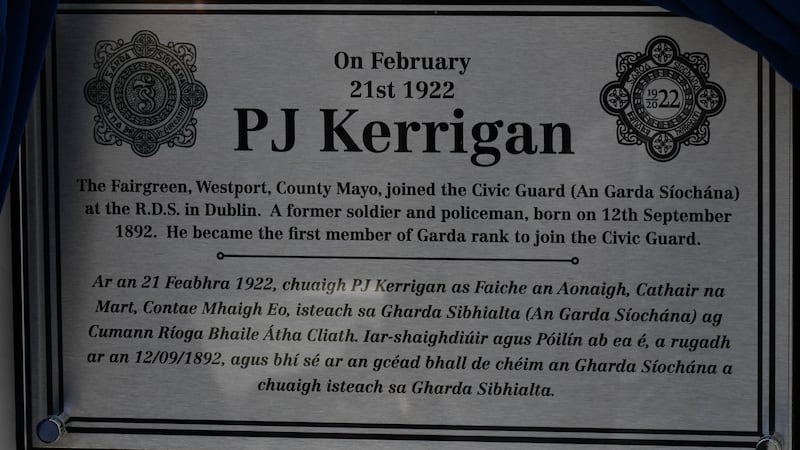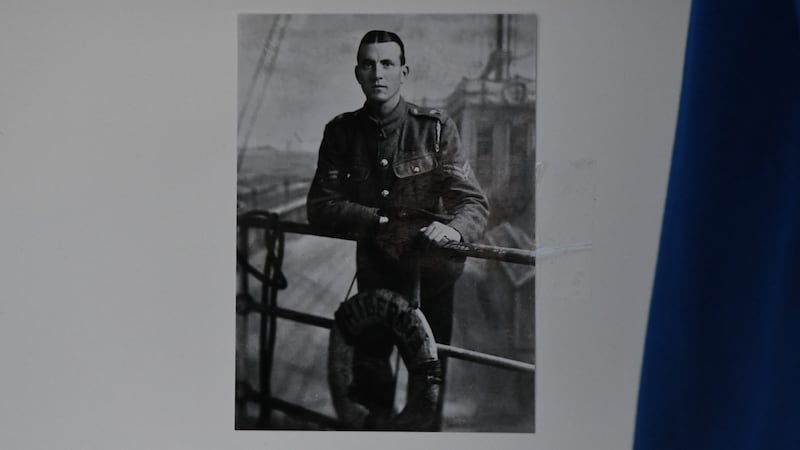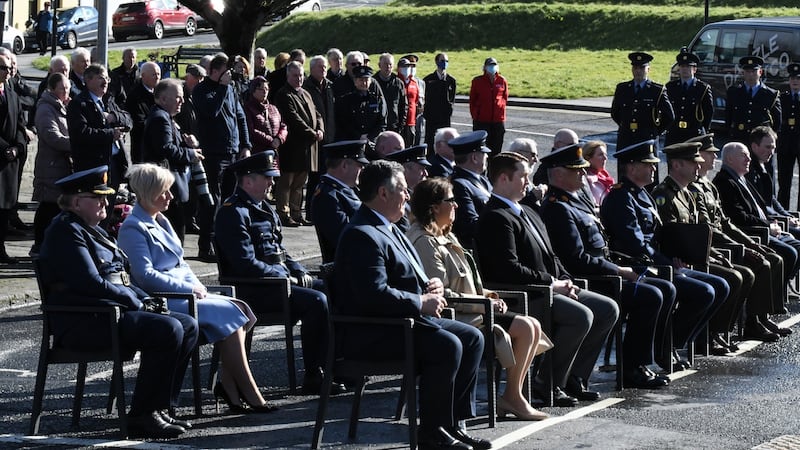A plaque to honour the first member of the Civic Guard (which later became An Garda Síochána) was unveiled in Westport, Co Mayo on Monday.
Patrick Joseph (PJ) Kerrigan, from Fairgreen in the town, had an extraordinary and tragic life.
His role as Garda No 1 began with a low-key ceremony in the RDS on February 21st, 1922.
Kerrigan, Patrick McAvinia and James Charles Clarke were enrolled in this yet untried force and began as Garda No 1, No 2 and No 3 respectively. It was not until two weeks later that the Provisional Government publicly announced the formation of the new force.
The three men were all ex-RIC. Despite the role of the RIC, backed up by the Black and Tans and the Auxiliaries during the War of Independence, the new police force was sorely lacking in professional knowhow and the RIC was the only obvious source of expertise.

The government circumvented these qualms by only recruiting those ex-RIC men who had been in “sympathy with the Sinn Féin movement” during the War of Independence.
Why Kerrigan became the first recruit is uncertain, but the force's first commissioner, Michael Staines, was a friend of his family.
Kerrigan's family had republican sympathies. His brother Christopher was active with the IRA during the War of Independence in England.
Struck a republican
Kerrigan was not only the first recruit, but ignominiously became one of the first to be dismissed. In August 1922, during the Civil War, he struck a republican prisoner who called him a “Black and Tan”.
The incident revealed the depths of suspicion that followed ex-RIC members who joined the Civic Guard. These suspicions resulted in open mutiny in May 1922 when new recruits complained about the number of RIC officers in the senior ranks.
The incident was so serious that the Provisional Government reacted by making the new force an unarmed one – a farsighted decision which has done much to engender respect for An Garda Síochána over the last century.
That might have spelled the end of Kerrigan's career as a servant of the new State, but he joined the National Army in March 1923 and a year later, the Dublin Metropolitan Police (DMP).
He was allocated to Chancery Lane Station in ‘A’ Division on the south side of Dublin City, and wore collar numerals ‘A.117’. He served briefly with the DMP Band and played the clarinet.

When the DMP was dissolved and incorporated into An Garda Síochána in 1926, Kerrigan found himself back in the force that had dismissed him four years previously.
Married by now with four children, Kerrigan might have expected his travails to be at an end, but he fell ill in 1925 and his pay was reduced as a result. He ran up debts and was charged with breaches of the disciplinary code. He promised his superiors he would pay back the money.
“I respectfully beg to state that I did not in any way incur the debts with the intention of evading payment, but as will be understood my wages up to now were so small that it was almost impossible to pay a large rent and keep a wife and four children with that degree of respectability my position requires,” he wrote.
His appeals were obviously unsuccessful as he left Ireland in February 1926, and was never seen by his family again.
He emigrated first to Liverpool and then to Canada, before finally settling in the United States. America provided a means for generations of European emigrants to reinvent themselves and start again.
Kerrigan changed his name from PJ to Joseph, and his date of birth from 1892 to 1898.
He worked as a porter and later as an ambulance driver at St Peter's Hospital, Albany. In 1933 he met and bigamously married Minnie Kleinberger, then aged 25 and of Austrian-Jewish extraction, and they resided at 14 Catherine Street, Albany. They had two children: son Michael, born in May 1935, and daughter Rosemary, born a year later.
His Irish wife did not die until 1939. In 1941 Kerrigan married his second wife, this time in a church ceremony.
The extraordinary story of Garda No 1 came to the attention of Garda Jim Herlihy when he was stationed at Bantry in Co Cork in 1995.
Garda Herlihy, who has since gone on to be a full-time historian, was told by a colleague that there was a man living in a nursing home who claimed to be the son of the first Garda recruit.
Never returned
James Francis Kerrigan was indeed PJ Kerrigan's son. Garda Herlihy inquired as to what happened his father. Mr Kerrigan responded that he had no idea as his father had left them in 1926 and never returned, but other family members had settled in New York.
In the days before internet searches, Garda Herlihy acquired the CD-Rom for the New York phonebook and searched it looking for Kerrigans. He came across one in the Albany area. The Michael Kerrigan on the end of the phone was a nephew of PJ Kerrigan.

James Francis Kerrigan found out for the first time that his father had died on March 15th, 1946 and was buried in St Agnes' Cemetery in Albany.
It was not the first fortuitous circumstance. James Francis had a daughter, Yvonne, who lived in the San Jose/Santa Cruz area of California.
She lived just 10 minutes’ drive away from Michael Kerrigan, PJ’s son by his American marriage.
The Irish and US families of Garda Recruit No 1 met in 1996, 70 years after PJ Kerrigan walked out on his Irish family and almost 75 years after he became the first member of the force.
Mr Herlihy visited Kerrigan’s grave in 2003 and laid his Garda hat on it. “He had been in three police forces and two armies in the space of 10 years,” he said.
“He was only 54 when he died, but he lived an extraordinary life. To emigrate is one thing, to start another family was quite another. He seemed to just drive on with his life without looking back.”
Members of both his Irish and American families were participating in the ceremony today.







